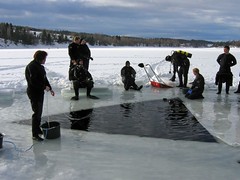 Image by asbjorn.hansen via Flickr
Image by asbjorn.hansen via Flickr
There are some basic procedures which are taught during ice diving training, without going into detail some of these would include: determining whether any given area is safe for diving, how ice is formed, dive site preparation, safety drills and equipment requirements.
Other topics covered during training include: Emergency situation procedures where divers will learn how to react should they become displaced from their line tender, dealing with frozen air supplies and how to handle the impact of the underside of the ice during an unexpected or uncontrolled ascent. Unlike most forms of scuba diving where gearing up, debriefing and a boat ride is all that is required to reach your destination; Ice diving requires a lot more effort and preparation- Divers will seek an area of potential and conclude whether the area is suitable for diving and if the ice holds the right requirements to perform a dive, next the divers will, in many cases, have to shovel the area clear of snow to reach the bare ice, this is then followed by cutting a hole in the ice using either a chainsaw or an ice saw. The final steps typically involve organizing the line tenders and gearing up.
The line tender which is attached to each diver is an important safety item in ice diving, this is because without them, divers could easily become lost. Should a diver lose sight of the exit/entry point he is likely to become extremely disorientated and could eventually lead to being unable to return to the surface (this has been a common cause of death in ice diving in the past), this is especially the case when diving in an area of low visibility, where you are more likely to lose sight of the exit/entry hole.
The scuba equipment used when ice diving is typically similar to normal scuba diving, although dry suits tend to take priority over wetsuits... And gloves, hoods and boots are definitely mandatory. One addition would be the line tender which tends to fit over the divers body between the wetsuit and the BCD, allowing for divers to shed their equipment if needed during an emergency and remain attached to the line.
It is very important that divers have reliable gear which is known to withstand the temperatures they will be facing. Some items on the market just can't keep up and fail under the freezing temperatures, make sure you do proper research into what gear is reliable for ice diving. It is also very important that all divers use regulators and not rebreathers, the rebreather has been at the center of ice diving deaths in the past.
Ice diving is definitely not for the weak and ice divers will tell you that straight. You need to be able to think clearly under stressful conditions, you need to be determined and you need to understand the risks. Though for those already involved in ice diving, they can vouch for the unique atmosphere present under the endless ceiling of ice with only their line tender holding them back from the abyss. Ice diving during the winter months will also, in some locations allow for water visibility that surpasses the imagination.
Thanks to Dive Time for this article
Kathy Dowsett
www.kirkscubagear.com

No comments:
Post a Comment